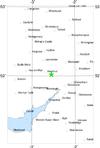| DATE | 17/12/1896 |
| ORIGIN TIME | 05:32:00 UTC |
| LOCATION | 52.020 -2.550 |
| DEPTH | 20.0 km |
| MAGNITUDE | 5.3 ML |
| LOCALITY | HEREFORD |
HEREFORD
The felt area of this earthquake covered almost all of England and Wales; as far east as Norwich, and as far north as Kendal (and possibly further at very low intensity). It was felt weakly in E Ireland and in Cornwall. Significant damage was caused at Hereford and in the neighbourhood. In Hereford itself there was slight damage to the cathedral and other churches, chiefly the fall of small bits of ornamental stonework. More than 200 chimneys in Hereford were damaged, many were twisted. The worst damage was in villages just to the east of Hereford. According to Davison (1899) there were 73 places where "marked" damage to buildings occurred, 55 in Herefordshire, seventeen in Gloucestershire and one in Worcestershire. Isolated damage occurred at such places as Hay-on-Wye, Stourbridge and Worcester, and in some cases even further afield in places where generally the intensity was quite low.
The epicentre was about 6 km ESE of Hereford. There was a sequence of foreshocks in the six hours preceding the main shock, two of which seem to have been quite substantial and are included in this catalogue, although the magnitude determination is probably not very accurate. The exact number of foreshocks is uncertain - since all occurred at night it is likely that the time observations are not very good and some of those listed by Davison (1899) are surely duplicates. The aftershocks are fewer and weaker.
It was alleged in some newspapers that a woman died of fright at Hereford, but this is denied by local sources. However, an apparently reliable source states that a woman at Hagley (a village just E of Hereford) suffered a stroke shortly after the earthquake, so the report may have some foundation after all.
The occurrence of the earthquake coincided almost exactly with the appearence of a bright meteor over much of the affected area This is not the only instance of such a coincidence, but it is the best observed one.
The earthquake is very well documented, since for this event Charles Davison published the results of his macroseismic survey in extenso in book form.
Sources: Davison (1899), Principia (1982), BGS material.




